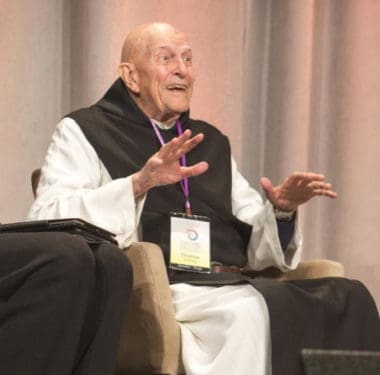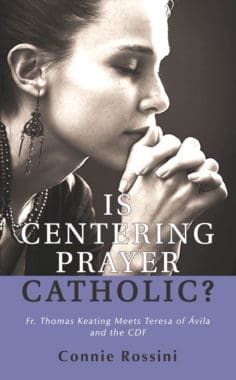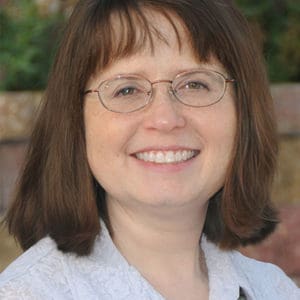Centering Prayer’s Misunderstanding of Contemplation
The following is an excerpt from Connie’s new book
Is Centering Prayer Catholic? Fr. Thomas Keating Meets Teresa of Ávila and the CDF.
This excerpt comprises Chapter Five: The Nature of Contemplation.
 Fr. Keating writes, “Contemplation is a fundamental constituent of human nature and hence available to every human being.”[1] This is a serious error. It makes contemplation into a merely human action, like thinking or loving. Fr. Keating says that Christian contemplation and Buddhist meditation “are basically the same thing,” and both employ many methods.[2] He also says, “Contemplation… is not so much a gift as a given.”[3] Contrast this with the Catechism: “Contemplative prayer is the simplest expression of the mystery of prayer. It is a gift, a grace; it can be accepted only in humility and poverty.”[4]
Fr. Keating writes, “Contemplation is a fundamental constituent of human nature and hence available to every human being.”[1] This is a serious error. It makes contemplation into a merely human action, like thinking or loving. Fr. Keating says that Christian contemplation and Buddhist meditation “are basically the same thing,” and both employ many methods.[2] He also says, “Contemplation… is not so much a gift as a given.”[3] Contrast this with the Catechism: “Contemplative prayer is the simplest expression of the mystery of prayer. It is a gift, a grace; it can be accepted only in humility and poverty.”[4]
What does this mean more concretely? If contemplation is a gift, as the Catechism says, then God gives it as he wills and to whom he wills. Contemplation is really a deeper entering into the life of God through intimacy with Christ. It is not an altered state of consciousness. It cannot be achieved by human endeavor. Although God wills to draw every person into this intimacy, that does not mean that everyone, wherever he may be in the spiritual life, has immediate access to it. Human nature is not enough to make one a contemplative. Even the sacramental grace given at Baptism is insufficient to make one a contemplative. Contemplation requires a special act of God. When the soul has done all it can with ordinary grace to draw near to God, God draws near to the soul. This is the orthodox view.
Letter to the Bishops indicates that Fr. Keating’s mistake is a Gnostic one:
In combating the errors of pseudognosticism the Fathers [of the early Church] affirmed that matter is created by God and as such is not evil. Moreover, they maintained that grace, which always has the Holy Spirit as its source is not a good proper to the soul, but must be sought from God as a gift.[5]
Another error reveals itself in Fr. Keating’s equating of Centering Prayer with the acquired contemplation[6] or prayer of simplicity which is commonly found in Teresa’s third and fourth mansions.[7] Acquired contemplation is produced by a soul who is practiced in prayer and virtue, cooperating with ordinary grace. But this acquired contemplation is essentially different from the infused contemplation that is initiated by God. Acquired contemplation is really just a simplified form of meditation. One looks at a holy card, pictures Christ in one’s mind, or thinks about a truth of faith. Almost immediately one is moved to sit quietly in God’s presence, loving him without using words. This quiet state may last for a few minutes. Then one returns to a sacred picture, image, or thought about God and begins the process again. One always begins with some meaningful content—a thought, a word, or a picture. Knowledge and love, the mind and the heart, lead one to adore God silently. One never begins with striving to silence these faculties.
In contrast, infused (sometimes called supernatural) contemplation cannot be produced or prolonged by human activity—or lack of activity. Meditating on the life of Christ can prepare one for this gift, but it cannot achieve it. Even less so can trying to quiet one’s faculties on one’s own. The essential element of infused contemplation is not the quiet, but the action of God. No merely human action can ever compel God to act. That is why we call contemplation a gift.
Perhaps Fr. Keating’s misunderstanding of the distinction between acquired and infused contemplation explains his teaching that one should ignore every communication from God during one’s centering time. Perhaps he believes that these “communications” are really a product of one’s own psyche, so they can be set aside at will. Teresa of Ávila tried to resist the favors of God at first. She did not understand them, and some spiritual directors cautioned her against them. Here she speaks of the results of this exercise:
By resisting the consolations and favours of God I gained this that His Majesty Himself taught me. For previously I had thought that, if I was to receive favours in prayer, I must go apart by myself a great deal, and so I had hardly dared to stir. Then I began to see how little this had to do with it; the more I tried to think of other things, the more completely the Lord enveloped me in that sweetness and glory until I felt so completely surrounded by it that I could not flee from it in any direction; and thus matters continued.[8]
She was unable to resist, try as she might. All attempts to ignore God were futile. When God communicates with us through locutions or visions, we can try to ignore them and set them aside. Teresa says we will not truly be able to do so. And union with God itself is as impossible to resist as it is to produce. It is outside human control.
 Is Centering Prayer Catholic? is available as an ebook and a paperback through Amazon.com. The paperback is also for sale at other online retailers.
Is Centering Prayer Catholic? is available as an ebook and a paperback through Amazon.com. The paperback is also for sale at other online retailers.
[1]Fr. Thomas Keating, Open Mind, Open Heart, 20th anniversary ed. (London: Bloomsbury, 2006), 2.
[2]Fr. Thomas Keating, “An Interview with Fr. Thomas Keating,” interview by Jonathan F. P. Rose, http://www.garrisoninstitute.org/an-interview-with-father-thomas-keating (accessed August 15, 2015).
[3]Open Mind, Open Heart, 120 (emphasis in the original).
[4]Catechism of the Catholic Church (2nd ed.). (Washington, DC: Libreria Editrice Vaticana-United States Conference of Catholic Bishops, 2000), paragraph 2713.
[5]Letter to the Bishops of the Catholic Church on Some Aspects of Christian Meditation, no. 8.
[6]Teresa calls this type of prayer recollection, but says it is not supernatural. Following Teresa, Carmelites usually call it acquired recollection.
[7]See, for example, Open Mind, Open Heart, 4.
[8]St. Teresa of Avila, Life, E. Allison Peers, translator (New York: Sheed and Ward, 1946), 24.2.
Photography: Detail from Thomas Keating, discussion with the Dalai Lama Boston 2012, “christopher”, 14 October 2012, CCA, Wikimedia Commons. Cover of Is Centering Prayer Catholic? Fr. Thomas Keating Meets Teresa of Avila and the CDF by Connie Rossini used with permission.





